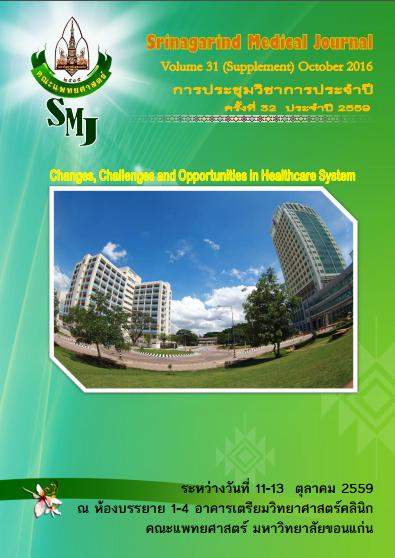The potential use of secondary metabolites from Bacillus amyloliquefaciens to control Acinetobacter baumannii
Keywords:
antimicrobial compound, nosocomial infection, secondary metabolitesAbstract
Background and Objective : Acinetobacter baumannii is an important cause of hospital-derived infection or nosocomial infections in many hospitals. The bacterium has an ability to survive for a long time on common surfaces including medical equipments and drug resistant isolates have been increasingly reported. Bacillusamyloliquefaciens N3-8 was isolated from soil. The secondary metabolites that were produced from this organism showed inhibition againstseveral pathogens including A. baumannii. This study aimed toobserve the range of inhibition and to set a model investigating the ability of crude proteinsproduced fromB. amyloliquefaciensinkillingA. baumanniion plastic surface.
Material and Methods:The inhibition activity of crude proteins from B. amyloliquefaciens N3-8 was observed against 28isolates ofA. baumannii by agar well diffusion. Imipenem, the drug of choice, was used as a positive control. The efficiency of crude proteinsfrom theN3-8 to kill or preventA. baumannii contamination was done on plastic surface and observed by colony count and streak plate methods using A. baumannii N5, which is a drug resistant isolate.Chlorhexidine of 1.5% was used as a positive control.
Results:Thecrude proteins could inhibit 71% (20/28) while imipenem could inhibit only 21% (6/28) of total A. baumannii isolates. Seven isolates showed no inhibition by both compounds, 15 isolates were inhibited by crude proteins but not imipenem, 5 were inhibited by both compounds and 1 isolate was inhibited by imipenem but not the crude proteins. Crude protein at concentrations of1, 2, 4, 8, 16 and 32 mg/ml that spread overthe 5x106 CFU/ml of N5 or the other way round could completely kill the bacterium. When N5 was applied before and after the crude proteins, the concentrations of2, 4, 8, 16 and 32 mg/ml could completely kill the N5 similar to 1.5% chlorhexidine.
Conclusion:These may be no advantage to use the crude proteins from B.amyloliquefaciens N3-8 for antiseptic purpose but they were superior to imipenem in killing the majority of A. baumanniiisolates. Further purification and characterization may lead to the discovery of a new drug for treatment of A. baumannii.




